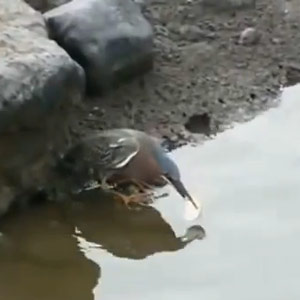Pratique | Débuter
Ces oiseaux qui utilisent parfois des appâts ou des leurres pour pêcher

Héron vert (Butorides virescens) utilisant un morceau de pain pour pêcher.
Source : image extraite d’une vidéo postée par MrBeemBom sur Youtube
Introduction
L’utilisation d’appâts pour pêcher est un comportement rare, décrit chez seulement douze espèces d’oiseaux, dont sept appartiennent à la famille des Ardéidés (hérons et aigrettes), les cinq restantes étant réparties au sein de quatre autres familles d’oiseaux (Accipitridés, Laridés, Alcédinidés et Eurypygidés). Les individus impliqués laissent flotter des objets pour attirer ou pour distraire des proies potentielles. Les appâts sont choisis dans l’environnement immédiat pour optimiser le taux de capture.
Les premiers oiseaux à utiliser cette méthode ont sûrement associé la présence d’objets flottants à celle de petits poissons. Le fait de les déplacer et d’utiliser des éléments similaires leur aurait permis d’acquérir ce comportement. Toutefois, malgré sa rareté et bien que l’on puisse assimiler l’utilisation d’un appât à celle d’un outil, cette pratique ne nécessiterait pas obligatoirement des capacités cognitives particulières.
Dans cet article, nous vous présentons plusieurs cas d’oiseaux pratiquant cette technique de pêche.
Abstract
Bait fishing is a behaviour described in only 12 species of birds, seven of which belong to the family Ardeidae (herons), the remaining five are scattered among four other bird families. Objects are placed by the bait fisher on the water or are used to attract or distract preys. Bait items are both selected from and placed within the environment to achieve enhanced prey capture success.
The evolutionary route to bait fishing has most likely been through an association between particular floating objects and the occurrence of fish prey. The repositioning of these floating objects and the collection of objects of similar character would have then been sufficient to achieve the bait fishing behaviour now seen.
Bait fishing falls within a commonly used definition of tool use. However, it is argued that, as with tool use and tool making in general, this does not necessarily imply special cognitive ability. Alternatively, this rarity could be explained if fishing is rarely more profitable than alternative foraging tactics.
We present you several cases of birds using baits to attract fishes.
Poursuivez la lecture de cet article, en vous abonnant dès maintenant !
Découvrez les Archives d’Ornithomedia.com
Pour seulement 10,00 €TTC/an (ou 6,00 € les 6 mois)
Profitez de plusieurs centaines d’articles en accès illimité et sans aucun engagement.
Compléments
À lire aussi sur Ornithomedia.com
- Certains oiseaux profitent d’une méthode de pêche particulière des dauphins
- Dans l’intimité des martins-pêcheurs
Ouvrage recommandé
Tool Behavior: The Use and Manufacture of Tools by anmals de Robert W. Shumaker, Kristina R. Walkup, Benjamin B. Beck
Sources
- Robert W. Shumaker, Kristina R. Walkup (2011). Animal Tool Behavior: The Use and Manufacture of Tools by Animals. Johns Hopkins University Press
- Ruxton, G. D. and Hansell, M. H. (2011), Fishing with a Bait or Lure: A Brief Review of the Cognitive Issues. Ethology (117). Pages : 1–9. http://onlinelibrary.wiley.com
- Pierre-Yves Henry Pierre-Yves Henry et Jean-Christophe Aznar (2006). Tool-use in Charadrii: Active Bait-Fishing by a Herring Gull. Waterbirds 29(2). Pages : 233-234. http://www.bioone.org/doi/abs/10.1675/1524-4695(2006)29%5B233:TICABB%5D2.0.CO%3B2
- Christina Riehl (2001). Black-Crowned Night Heron Fishes with Bait. Waterbirds: The International Journal of Waterbird Biology. Volume 24, numéro 2. Pages : 285-286. http://www.oeb.harvard.edu
- Scott K. Robinson (1994). Use of Bait and Lures by Green-Backed Herons in Amazonian Peru. The Wilson Bulletin. Vol. 106, No. 3. Pages : 567-569. http://www.jstor.org
- Floyd E. Heyes et Courtenay Rooks (2001). Bait-fishing by the Striated heron (Butorides striatus) in Trinidad. El Pitirre (14) numéro 1. http://web2.puc.edu/jco/pdf/Pitirre%2014(1)%202001.pdf#page=5
- Rory J. Post, Christine P. Kowal Post et J. Frank Walsh (2004). Little Egret (Egretta garzetta) and Grey Heron (Ardea cinerea) Using Bait for Fishing in Kenya. Waterbirds 32(3). Pages : 450 -452. http://www.bioone.org/doi/abs/10.1675/063.032.0311
- William E. Davis Jr (2004). Black-crowned Night-Heron vibrated bill in water to attract fish.Southeastern Naturalist 3(1). Pages :127-128. http://www.bioone.org
- Greg J. Roberts (1980). Apparent baiting behaviour by a Black Kite. Emu. http://www.publish.csiro.au/?act=view_file&file_id=MU9820053.pdf
- Joe Eaton (2011). Wild neighbours: Heron Bait and Other Bird Tools. The Berkeley Daily Planet. Date : 30/12. www.berkeleydailyplanet.com/issue/2011-12-30/article/39064?headline=WILD-NEIGHBORS-Heron-Bait-and-Other-Bird-Tools–By-Joe-Eaton





Aucun commentaire sur ce sujet
Participer à la discussion !